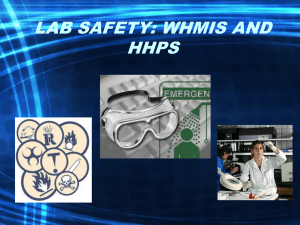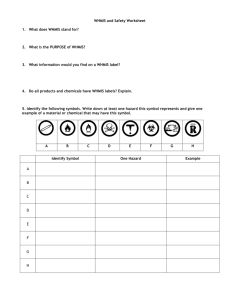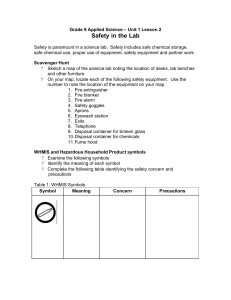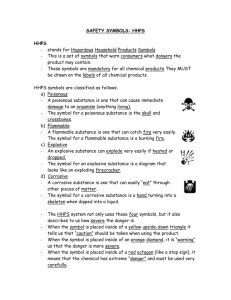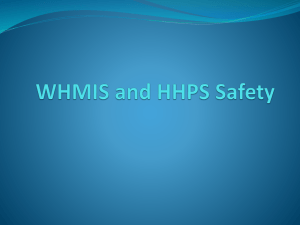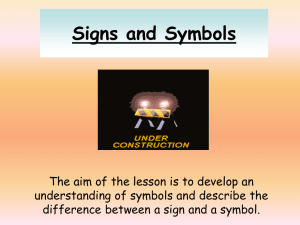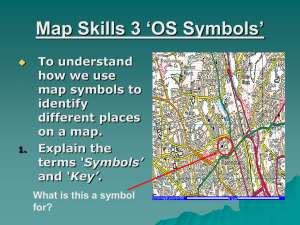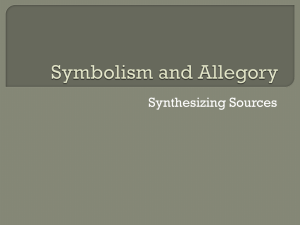Safety Symbols Worksheet: HHPS & WHMIS | Middle School
advertisement
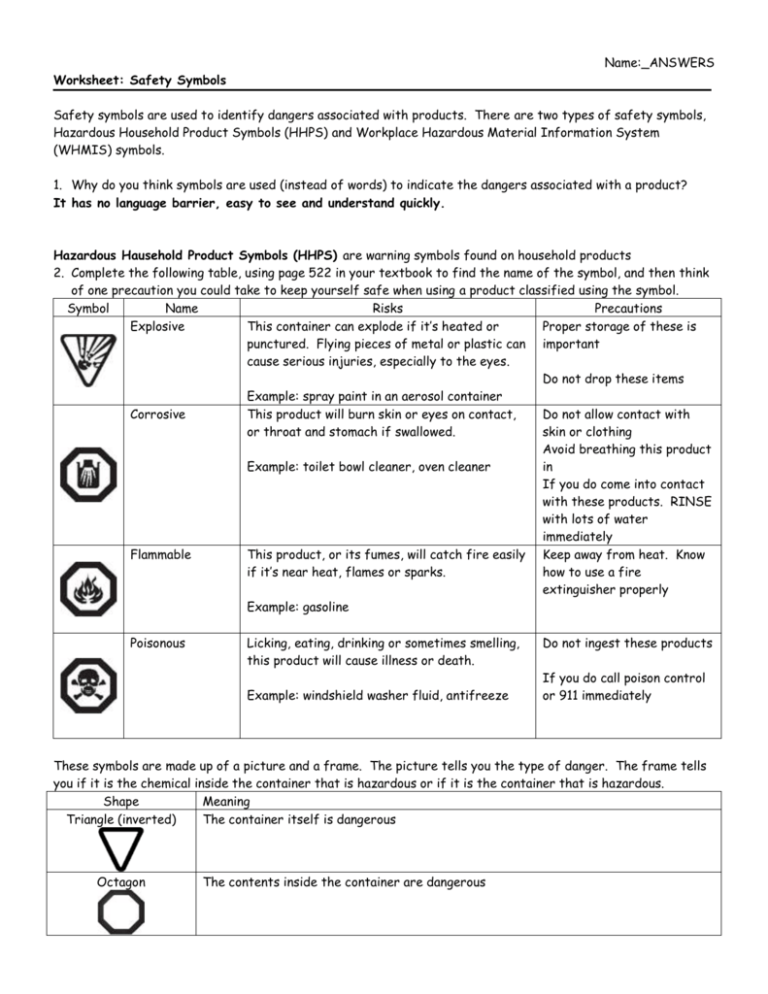
Name:_ANSWERS Worksheet: Safety Symbols Safety symbols are used to identify dangers associated with products. There are two types of safety symbols, Hazardous Household Product Symbols (HHPS) and Workplace Hazardous Material Information System (WHMIS) symbols. 1. Why do you think symbols are used (instead of words) to indicate the dangers associated with a product? It has no language barrier, easy to see and understand quickly. Hazardous Hausehold Product Symbols (HHPS) are warning symbols found on household products 2. Complete the following table, using page 522 in your textbook to find the name of the symbol, and then think of one precaution you could take to keep yourself safe when using a product classified using the symbol. Symbol Name Risks Precautions Explosive This container can explode if it’s heated or Proper storage of these is punctured. Flying pieces of metal or plastic can important cause serious injuries, especially to the eyes. Do not drop these items Example: spray paint in an aerosol container Corrosive This product will burn skin or eyes on contact, Do not allow contact with or throat and stomach if swallowed. skin or clothing Avoid breathing this product Example: toilet bowl cleaner, oven cleaner in If you do come into contact with these products. RINSE with lots of water immediately Flammable This product, or its fumes, will catch fire easily Keep away from heat. Know if it’s near heat, flames or sparks. how to use a fire extinguisher properly Example: gasoline Poisonous Licking, eating, drinking or sometimes smelling, this product will cause illness or death. Example: windshield washer fluid, antifreeze Do not ingest these products If you do call poison control or 911 immediately These symbols are made up of a picture and a frame. The picture tells you the type of danger. The frame tells you if it is the chemical inside the container that is hazardous or if it is the container that is hazardous. Shape Meaning Triangle (inverted) The container itself is dangerous Octagon The contents inside the container are dangerous Workplace Hazardous Materials Information System (WHMIS) symbols were developed to standardize the labeling of dangerous materials used in all workplaces, including schools. 3. Complete the following table, using page 522 in your textbook to find the name of the symbol, and then think of one precaution you could take to keep yourself safe when using a product classified using the symbol. Symbol Name Compressed gas Flammable and combustible materials Risks Precautions Contents under high pressure. Could explode if heated or dropped Keep away from heat Catches fire easily May ignite without warning Keep away from heat. Store it safely (not on a high shelf where it could fall) Don’t smoke near these product Store in a cool, fire proof area Oxidizing materials May cause combustible material to explode Increases fire hazards Keep away from combustible materials No smoking Wear protective equipment, including eye, face and hand protection Materials causing immediate and serious toxic effects These materials can cause death or immediate injury if swallowed, inhaled, or absorbed through skin. Wear respiratory equipment Materials causing other serious toxic effects These materials can cause life-threatening and serious long-term health problems in a person who is repeatedly exposed to small amounts Wear protective equipment Biohazardous infectious materials Contains living organisms that can cause harm (viruses, bacteria, parasites, etc.) Avoid handling or handle using proper protective equipment. Corrosive material Causes eye and skin irritation on contact, severe burns after long periods of contact. Proper protective equipment needed Dangerously reactive material May react violently with water. May explode if exposed or heat or shock. Avoid contact with water, store in dry area Wash and shower after using Work in well-ventilated areas Work in well-ventilated areas 4. Products with which WHMIS symbols should be stored separately? Why? Compressed gas, flammable and combustible materials, oxidizing materials and dangerously reactive. Because if one explodes it could cause a chain reaction including fire, flying objects, etc. 5. We store tanks of oxygen gas and hydrogen gas in the storage room at W-O. These gasses are under high pressure. Which WHMIS symbol would you expect to see on these tanks? Compressed GAS! 6. If acid splashed and lands on your skin, you skin will get irritated, and it may burn. Which WHMIS symbol would you expect to see on bottles of acid? Corrosive materials
